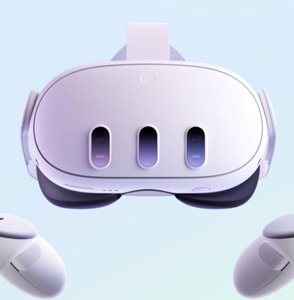Meta's Vision: A Glimpse into the Future of AR and VR
September 27, 2024, 10:02 pm
In the heart of Silicon Valley, Meta is pushing the boundaries of technology. At the recent Connect event, CEO Mark Zuckerberg showcased two groundbreaking devices: the Orion AR glasses and the Quest 3S VR headset. These innovations are not just gadgets; they are windows into a future where digital and physical worlds intertwine seamlessly.
The Orion AR glasses, a prototype, represent Meta's ambitious leap into augmented reality. Thick black frames encase a fully functional device, tethered to a small puck. This isn’t just a fashion statement; it’s a statement of intent. The glasses won’t hit the consumer market yet. Instead, they will serve as a testing ground for internal development. Meta is not rushing; it’s laying the groundwork for something monumental.
Imagine controlling your device with your thoughts. The Orion glasses utilize a wristband that picks up neural signals, allowing users to interact with digital content using their minds. This technology, born from the acquisition of CTRL-Labs, is a glimpse into a world where our brains become the interface. It’s a leap from touchscreens to thought screens.
Zuckerberg painted a vivid picture of the Orion’s capabilities. Users can multitask with multiple windows, play immersive games, and even hold video conferences with lifelike avatars. The potential is staggering. Yet, this is just the beginning. Meta aims to refine the Orion prototype into a consumer-ready product, though no timeline has been set. Patience is key in the tech world.
In contrast, the Quest 3S VR headset is ready for the masses. Priced at an accessible $299, it aims to democratize virtual reality. This device boasts high-resolution displays and an upgraded operating system that allows users to mirror their computer screens. It’s a bridge between the virtual and the real, making it easier for users to navigate both worlds.
The Quest 3S is not just about gaming, although that remains a highlight. Users can immerse themselves in experiences like the demo of Batman: Arkham Shadow. The controls are designed to be intuitive, making the transition into virtual environments smooth. However, a word of caution: some users may experience dizziness during intense gameplay. It’s a reminder that even in virtual worlds, our physical bodies still matter.
Meta’s Horizon OS powers the Quest 3S, designed for spatial computing. It supports both 2D apps like Facebook and Instagram and 3D experiences. This versatility is crucial as the lines between different types of digital interaction blur. Users can seamlessly switch from scrolling through social media to exploring a virtual landscape.
The Quest 3S also benefits from significant improvements in contrast and color during occlusion, where the physical world interacts with the digital. This enhancement makes the experience more immersive and realistic. It’s a small detail, but in the world of VR, such nuances can make all the difference.
Both the Orion and Quest 3S are part of Meta’s broader strategy to lead in the AR and VR space. The company is not just creating products; it’s crafting experiences. The recent announcement of new features for the Ray-Ban Meta smart glasses further illustrates this point. These glasses, while not AR in the traditional sense, integrate AI to enhance everyday life. They can translate languages in real-time and remember details like where you parked your car. It’s a blend of style and functionality, appealing to a wide audience.
The Ray-Ban Meta glasses have already seen impressive sales, with over 730,000 units sold in their first three quarters. This success indicates a growing appetite for smart eyewear, even if it doesn’t yet offer full AR capabilities. Meta’s partnership with EssilorLuxottica continues to evolve, hinting at more innovations on the horizon.
As Meta forges ahead, it faces competition. Snap recently unveiled its fifth-generation Spectacles AR glasses, targeting developers with a subscription model. The race is on, and Meta is keenly aware of the stakes. The tech landscape is shifting rapidly, and staying ahead requires constant innovation.
In this dynamic environment, Meta’s focus on internal development for the Orion glasses is strategic. It allows the company to refine its technology without the pressure of immediate consumer expectations. This approach could yield a more polished product when it finally reaches the market.
The future of AR and VR is not just about the devices themselves; it’s about the experiences they create. Meta is betting on a world where digital interactions feel as natural as breathing. The Orion and Quest 3S are stepping stones toward that vision.
In conclusion, Meta is not merely showcasing products; it’s unveiling a vision. A vision where augmented and virtual realities enhance our daily lives. The Orion AR glasses and Quest 3S VR headset are emblematic of this future. They are not just tools; they are gateways to new experiences. As we stand on the brink of this technological revolution, one thing is clear: the future is bright, and Meta is leading the charge.
The Orion AR glasses, a prototype, represent Meta's ambitious leap into augmented reality. Thick black frames encase a fully functional device, tethered to a small puck. This isn’t just a fashion statement; it’s a statement of intent. The glasses won’t hit the consumer market yet. Instead, they will serve as a testing ground for internal development. Meta is not rushing; it’s laying the groundwork for something monumental.
Imagine controlling your device with your thoughts. The Orion glasses utilize a wristband that picks up neural signals, allowing users to interact with digital content using their minds. This technology, born from the acquisition of CTRL-Labs, is a glimpse into a world where our brains become the interface. It’s a leap from touchscreens to thought screens.
Zuckerberg painted a vivid picture of the Orion’s capabilities. Users can multitask with multiple windows, play immersive games, and even hold video conferences with lifelike avatars. The potential is staggering. Yet, this is just the beginning. Meta aims to refine the Orion prototype into a consumer-ready product, though no timeline has been set. Patience is key in the tech world.
In contrast, the Quest 3S VR headset is ready for the masses. Priced at an accessible $299, it aims to democratize virtual reality. This device boasts high-resolution displays and an upgraded operating system that allows users to mirror their computer screens. It’s a bridge between the virtual and the real, making it easier for users to navigate both worlds.
The Quest 3S is not just about gaming, although that remains a highlight. Users can immerse themselves in experiences like the demo of Batman: Arkham Shadow. The controls are designed to be intuitive, making the transition into virtual environments smooth. However, a word of caution: some users may experience dizziness during intense gameplay. It’s a reminder that even in virtual worlds, our physical bodies still matter.
Meta’s Horizon OS powers the Quest 3S, designed for spatial computing. It supports both 2D apps like Facebook and Instagram and 3D experiences. This versatility is crucial as the lines between different types of digital interaction blur. Users can seamlessly switch from scrolling through social media to exploring a virtual landscape.
The Quest 3S also benefits from significant improvements in contrast and color during occlusion, where the physical world interacts with the digital. This enhancement makes the experience more immersive and realistic. It’s a small detail, but in the world of VR, such nuances can make all the difference.
Both the Orion and Quest 3S are part of Meta’s broader strategy to lead in the AR and VR space. The company is not just creating products; it’s crafting experiences. The recent announcement of new features for the Ray-Ban Meta smart glasses further illustrates this point. These glasses, while not AR in the traditional sense, integrate AI to enhance everyday life. They can translate languages in real-time and remember details like where you parked your car. It’s a blend of style and functionality, appealing to a wide audience.
The Ray-Ban Meta glasses have already seen impressive sales, with over 730,000 units sold in their first three quarters. This success indicates a growing appetite for smart eyewear, even if it doesn’t yet offer full AR capabilities. Meta’s partnership with EssilorLuxottica continues to evolve, hinting at more innovations on the horizon.
As Meta forges ahead, it faces competition. Snap recently unveiled its fifth-generation Spectacles AR glasses, targeting developers with a subscription model. The race is on, and Meta is keenly aware of the stakes. The tech landscape is shifting rapidly, and staying ahead requires constant innovation.
In this dynamic environment, Meta’s focus on internal development for the Orion glasses is strategic. It allows the company to refine its technology without the pressure of immediate consumer expectations. This approach could yield a more polished product when it finally reaches the market.
The future of AR and VR is not just about the devices themselves; it’s about the experiences they create. Meta is betting on a world where digital interactions feel as natural as breathing. The Orion and Quest 3S are stepping stones toward that vision.
In conclusion, Meta is not merely showcasing products; it’s unveiling a vision. A vision where augmented and virtual realities enhance our daily lives. The Orion AR glasses and Quest 3S VR headset are emblematic of this future. They are not just tools; they are gateways to new experiences. As we stand on the brink of this technological revolution, one thing is clear: the future is bright, and Meta is leading the charge.

